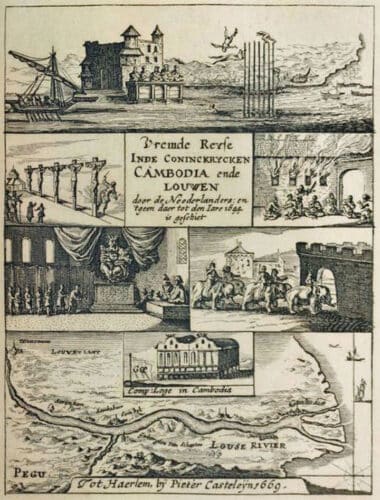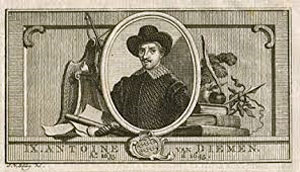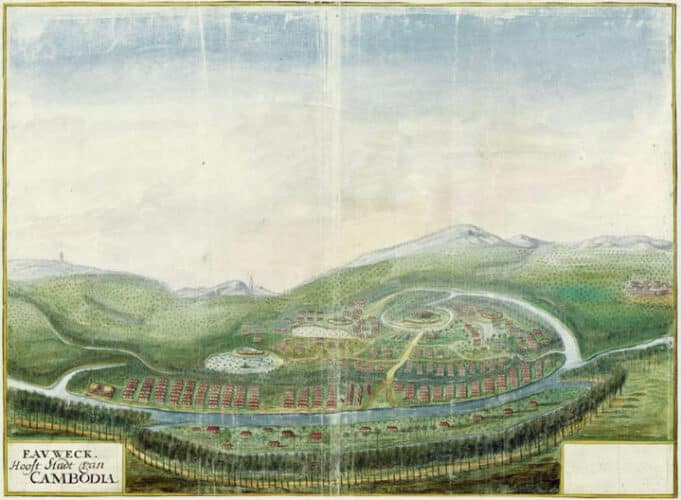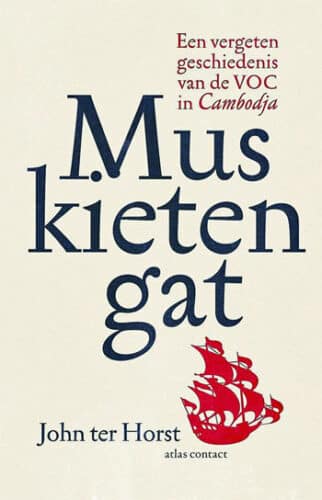Gerrit van Wuysthoff – a Dutch pioneer in Southeast Asia

Illustration in 'Vremde histories' by Gerrit van Wuysthoff (in 'The East India Company in Cambodia and Laos')
The first Dutchman and one of the first Europeans to visit Laos extensively was the merchant Gerrit Van Wuysthoff or Geeraerd van Wuesthoff, during a mission set up by him for the Vereenigde Oostindische Compagnie, the VOC in 1641-1642.
Although I have to correct right away because this area was not known as Laos at the time, but as the kingdom of Lan Xang Hom Kao or Lan Chang, the Land of a Million Elephants and White Parasols. For three and a half centuries this was one of the largest principalities in Southeast Asia and for that reason alone it was interesting for the VOC, which was always eager to expand its trading activities. Substantial parts of the area of what today forms northern and eastern Thailand were once part of this empire. The description Laos must have been in vogue almost four hundred years ago, because Van Wuysthoff corrupted it into the name Louwenlandt…
Van Wuysthoff's remarkable adventures actually begin in 1636. In that period, the VOC was fully engaged in the exploration of Southeast Asia and the Company already had two trading posts in Siam, namely in Patani and in the capital Ayutthaya. On June 10, 1636, the Dutch chief merchant Dirk Van Galen sailed with the VOC barge Oudewater through the Muskietengat, to the then Cambodian capital Lovek or Longvek, a city on the Tonlé Sap River, a tributary of the Mekong, about 50 km north of the current capital Phnom Penh. The city was chosen as the capital around 1553 by King Ang Chan (1515-1566) after the Siamese plundered and destroyed Angkor.
Van Galen was received with all due respect by the Japanese harbourmaster, but he soon became annoyed with the, in his Calvinistic eyes, very loose Cambodian morals and customs. In his diary he spoke of disgrace about the bare breasts of the women clad in meager loincloths. He was not at all pleased with the debauched Cambodian monarch Ang Tong Raechea (1608-1640). Van Galen could not hide his disgust when he wrote down how this monarch, in order to stimulate his almost inexhaustible sexual appetites, made a 'giggly' used a herbal potion that boosted him to unseen bed feats. But he was perhaps most disturbed by the Portuguese, a bunch Rot-Catholics' which apparently kept getting in his way. Nevertheless, Van Galen was able to convince Ang Tong Raechea to a lucrative deal: he was allowed to buy thousands of deerskins from Laotian traders who came down the Mekong in the name of the VOC. In fact, he even got permission to build a warehouse in Phnom Penh as a warehouse for these skins.

Anthony Van Diemen (1593-1645) in Batavia
The VOC played a high game. Just as this had happened before in Siam, she demanded a monopoly on the most lucrative trade for the VOC, in this case the purchase and export of deerskins from Cambodia. This demand had everything to do with the prohibition that the Japanese emperor Togugawa Somethinguna had issued in 1633 for the Japanese to trade with foreign countries any longer. This economic isolationism played into the hands of the Dutch, because to nevertheless guarantee the supply of overseas products, he appealed to the Dutch. The Dutch were paid by the Japanese with silver, which in turn was used to purchase fabrics and textiles, which in turn served as payment for the spices purchased in the East and then shipped with a ship filled with cloves, mace, nutmeg and cinnamon to Europe.
The potent but above all very cunning Cambodian king was prepared to grant the VOC this monopoly on the condition that Van Galen would lend him a hand. After all, the Cambodians feared an attack on Lovek by the Siamese king Prasat Thong and so they asked Van Galen to give them the cannons of the Oudewater. Van Galen thought this was an extremely ridiculous idea, because how could he defend himself without naval guns, once back on the high seas, against the lurking Portuguese? He therefore resolutely rejected the deal, which in turn aroused the anger of Governor-General Anthony Van Diemen (1593-1645) in Batavia. The latter was very keen to remain good friends with the Cambodians. This ambitious governor-general, who was keen on economic expansion, even toyed with the idea of annexing Cambodia and renaming it Oud-Holland…

Khone Phapheng Falls in Laos
It was the same Van Diemen who, in the spring of 1641, ordered Gerrit van Wuysthoff to explore Lan Chang or Laos. Laotian traders had arrived in Batavia a few months earlier with an invitation from their ruler Sulinya Vongsa (1618-1690), who had come to power in 1638 and is today regarded as one of the most important rulers of Lan Chang. Known as a protector of art and religion, he was an intelligent ruler who not only succeeded in making peace with his powerful neighbor Ayutthaya, but also established the border between Siam and Lan Chang. Recognizing that Lan Chang was vulnerable due to the fact that the principality's only connection to the sea was via the Mekong, he set out for geopolitical reasons to find a strong seafaring nation that could defend the maritime interests of his empire. He believed that the VOC could qualify for this role and therefore contacted Van Diemen.
On July 20, 1641, Van Wuysthoff departed from the VOC warehouse in Lovek with 12 sloops loaded with gifts and merchandise across the Mekong to Vientianne, the capital of Lan Chang, which Van Wuysthoff invariably referred to as Winckjan in his travel journal. The VOC merchant not only had to map the Mekong and investigate its navigability. One of the main reasons for this expedition was the gold in Lan Chang, a lot of gold that, to the astonishment of Gerrit van Wuysthoff, was often buried in the ground under the floors of the houses, along with silver and precious stones, because the Lao claimed to have more than enough wealth… But he had to look out for the possibilities of purchasing sealing wax, resins and the raw materials for incense.

'Eauweck capital city of Cambodia' Bird's eye view of Eauweck or Lawec/Lovek/Khum Peam Lvek, Cambodia (1665) Johannes Vingsboom. National Archives.
After an uneventful journey, he arrived in Vientiane where he was received with all due respect and spent two months at court. His diary shows that he had a very attentive mind and made notes with an eye for detail about the manners and customs of the people and at court.
Van Wuysthoff's mission was not an unqualified success. No VOC post would ever be established in Vientianne. The long supply route with a series of dangerous waterfalls made this almost impossible. In Lan Chang he had made the necessary contacts and the VOC could count on the goodwill of the monarch and his entourage, but that was not the case in Cambodia. Quite serious incidents had occurred between the VOC and the Cambodians on a few occasions, and after the mysterious death of Ang Tong Raechea, relations with his successor Batom Reachea (1616-1642) soured completely. The young monarch had nothing to do with the Dutch and preferred to trade with the Portuguese. When Batom Reachea and his followers are liquidated by his half-brother Ramathipadi I, better known as Ponhea Chan (1615-1659), during a coup d'état, the fence is completely over. Ponhea Chan hated the VOC and after a Dutch delegation had been treacherously put to the sword, the VOC decided to block the Mosquito hole with five warships. This was the beginning of the end for the VOC in Cambodia and Laos. After all, the Cambodian adventure of the VOC ended here on 11 June 1644 with a massacre that cost 62 dead and 145 wounded. The result of a successful ambush laid by the Cambodians. A frustrated Van Diemen wanted to take revenge and attack Cambodia together with the Siamese, but after Van Diemen's sudden death on 19 April 1645 in the VOC residence in Batavia, these plans finally fell through.

In 2007, Peter Meijwes retraced Van Wuysthoff's journey from Phnom Penh to Vientanne for VPRO radio. This report inspired John ter Horst for the nice reading book 'Mosquito Hole: A Forgotten History of the VOC in Cambodia'. A book that I recommend to anyone who wants to know more about this forgotten but fascinating piece of history.


Interesting story again, Lung Jan, that's how I like to read them.
About Vientiane, which is a French corruption of เวียงจันทน์ wieang jan (two middle tones). Wieang is a walled city and Jan is sandalwood, so the Sandalwood City. Van Wuysthoff was therefore a bit closer with his Winckjan than the French with their Vientiane
Thanks for this piece of history!
My thanks very well written, and very close to the truth. The VOC from leggings perfect. From Australia well Done.
Thanks again for a nice piece Jan. Always good to learn something about the history of the region. If the reader can only take away two things, I hope it is that 1) a great Thai empire beyond its current borders is a myth masking internal strife and colonization. 2) the kingdoms also benefited from relations with the west (and the various parties played off each other for their own interests).
Great story about the VOC Compliments for that! Will purchase the book Mosquito Hole when I return home in April. Such stories make Thailandblog interesting. Thanks Lung Jan.
Nice piece John, thank you. Has a book been written about the VOC in Thailand?
Another very fascinating contribution about the history of this region. I look forward to the next research about the VOC past. Many thanks, Lung Jan!